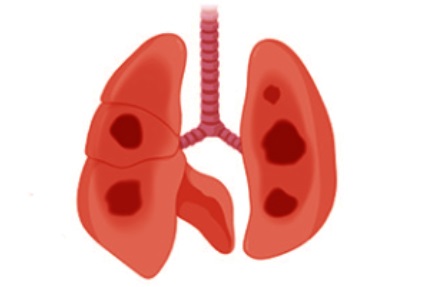Nikhil Prasad Fact checked by:Thailand Medical News Team Jan 03, 2025 11 months, 3 weeks, 5 days, 14 hours, 13 minutes ago
Medical News: COVID-19, caused by the SARS-CoV-2 virus, has reshaped how the world perceives infectious diseases. While its effects are widely felt, the virus’s specific impacts on different parts of the body, especially the lungs, remain a subject of intense research. The lungs, as the primary site of infection, exhibit a range of damages that extend from mild inflammation to severe complications like acute respiratory distress syndrome. Despite extensive studies, understanding the virus’s detailed metabolic effects on lung tissues has been a challenge. This
Medical News report sheds light on groundbreaking research conducted by scientists from the University of Oklahoma, San Diego State University, and the University of Iowa in USA. Their work delves into how SARS-CoV-2 infection alters metabolism in different regions of the lungs. By examining the metabolic changes in a mouse model, the researchers offer new perspectives on why certain parts of the lungs are more vulnerable to damage.
 SARS-CoV-2 Unevenly Affects Metabolism in the Peripheral Regions of the Lungs
The Scope of the Study
SARS-CoV-2 Unevenly Affects Metabolism in the Peripheral Regions of the Lungs
The Scope of the Study
The study focused on analyzing metabolic changes in the lungs of mice infected with SARS2-N501YMA30, a mouse-adapted strain of the virus. Researchers divided the lungs into central and peripheral regions and compared their metabolic responses. Using advanced techniques like spatial metabolomics, they uncovered specific alterations in fatty acids, amino acids, and other vital metabolites.
Unlike many previous studies that relied on blood or urine samples, this study analyzed lung tissues directly. This approach allowed scientists to pinpoint localized metabolic disruptions that broader analyses might miss. By segmenting lung tissues, the study provided an unprecedented view of how different areas respond to viral infection.
Key Findings on Metabolic Disruptions
One of the most striking discoveries was the uneven metabolic disturbance across lung regions. The central lung tissue exhibited higher viral loads, while the peripheral tissue suffered more severe metabolic disturbances. This disparity offers insights into why the peripheral lungs often endure more extensive damage during COVID-19.
Fatty acids, essential for energy production and cellular integrity, were significantly reduced in infected peripheral lung tissues. Amino acids, the building blocks of proteins, also showed marked decreases, with variations depending on the infection severity and duration. Eicosanoids, crucial for regulating inflammation, were found to be lower, particularly in the peripheral lung areas. These findings highlight how the virus targets and disrupts vital metabolic pathways, leading to localized damage.
Interestingly, prostaglandins - molecules involved in inflammation - displayed mixed responses. Prostaglandin D2 and F2α were elevated in central tissues with higher viral loads but were significantly reduced in the peripheral areas. This suggests a complex interplay between inflammation and tissue-specific viral impacts.
>
Persistent Effects Beyond Acute Infection
The study also examined metabolic changes 20 days after infection to simulate post-acute sequelae or long COVID. Even after the acute phase of infection, many metabolic disruptions persisted. Some mice displayed signs of recovery, while others showed ongoing abnormalities, particularly in the peripheral lung tissue. This variation mirrors the diverse recovery trajectories observed in human COVID-19 patients.
A notable finding was the increase in certain purine metabolites, which are essential for DNA and RNA synthesis, in the later stages of infection. This could indicate ongoing tissue repair processes or lingering viral effects. These insights are crucial for understanding the long-term impacts of COVID-19 and guiding treatment strategies.
Implications for Future Research and Treatments
This study’s findings have profound implications for both research and clinical practice. By revealing how SARS-CoV-2 unevenly disrupts lung metabolism, the study provides a roadmap for developing targeted interventions. For instance, therapies aimed at restoring fatty acid and amino acid levels in the lungs could mitigate tissue damage and improve recovery outcomes.
Moreover, the insights into prostaglandin dynamics suggest potential avenues for modulating inflammation in COVID-19. Balancing pro-inflammatory and anti-inflammatory responses could be key to preventing severe lung damage.
Conclusion
This research marks a significant leap in our understanding of COVID-19’s localized effects on lung metabolism. By focusing on spatial metabolomics, the study uncovers the intricate ways the virus impacts different lung regions. These findings not only enhance our knowledge of the disease but also open new doors for targeted therapies.
As the world continues to grapple with COVID-19 and its aftermath, studies like this underscore the importance of nuanced research approaches. By decoding the virus’s specific impacts, scientists can pave the way for more effective treatments and interventions.
The study findings were published in the peer-reviewed journal: iScience.
https://www.sciencedirect.com/science/article/pii/S2589004224029547
For the latest COVID-19 News, keep on logging to Thailand
Medical News.
Read Also:
https://www.thailandmedical.news/news/doctors-warn-that-hmpv-can-trigger-deaths-in-children-with-covid-19
https://www.thailandmedical.news/news/sustained-effects-of-sars-cov-2-spike-protein-on-human-endothelial-cells
https://www.thailandmedical.news/news/covid-19-causes-disruptions-in-blood-brain-barrier-via-mitochondria-impairment-and-endothelial-dysfunction
https://www.thailandmedical.news/articles/coronavirus
